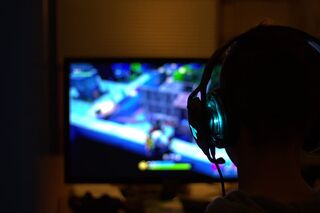Video Game Addiction
There’s No Such Thing as Video Game Addiction… Right?
What the debate about Gaming Disorder means for your video gaming habit.
Posted July 22, 2020 Reviewed by Kaja Perina
If you play video games, you’ve likely had the experience of staying up far past your bedtime, repeatedly re-spawning or clicking "New Game." Maybe these sessions have even lasted until dawn. Maybe you’ve skipped a meal or failed to take a shower because you were so involved in a game. If you have, you may have wondered if this behavior—this apparent loss of control over your priorities—qualified as video game addiction. But are the games you’ve been “addicted to” really functioning like cigarettes or alcohol inside your brain? One way of describing addiction is compulsively engaging with a behavior despite its aversive outcome (according to a report by Vox). If your game-playing has resulted in negative real-world consequences, like being late to your job, or arguing with your spouse or partner, yet you still find it difficult or impossible to stop gaming, perhaps addiction really is the right word.

Last year, the World Health Organization classified Gaming Disorder as a medical illness in the ICD-11 (the International Classification of Diseases, 11th Revision). To qualify for the disorder, an individual needs to show significant impairment in at least one major area of functioning (like employment or relationships), and the disruption must be present for at least 12 months. A controversy quickly followed the WHO’s decision. Some mental health professionals criticized it: as reported by the MIT Technology Review, more than two dozen researchers and scientists sent an open letter to the WHO stating their opinion that “gaming disorder” was not premised upon good science. Studies exist, they contended—such as this one, from the University of Cardiff—indicating that an apparent addiction may actually reflect the other underlying psychological conditions that problem gamers are likely to have, which in turn suggests that gaming disorder is not a discrete condition. The gaming industry itself was not impressed with the WHO’s choice, and some claimed that the fear of addiction to video games was just another expression of technophobia, which (as the New York Times conjectured, in a long article) has been around for centuries. And gamers themselves revolted, too, worrying that the WHO was pathologizing normal behavior. After all, according to Vox, the number of gamers around the world has, by now, likely topped two and a half billion (after hitting 2.3 billion in 2018).
Whether or not the ICD-11’s “gaming disorder” classification is meaningful, it’s more than just colloquially possible to see video gaming as an addiction. For instance, the New York Times reported on research indicating that, like addictive drugs, video games can trigger the brain’s reward circuits. This recalls the famous Olds and Milner study of rats that could press a metal bar to receive direct stimulation to the pleasure centers of their brains, and would do anything for a bar press, including depriving themselves of food and water. Furthermore, several studies, as the Times indicated, indicate potential differences related to dopamine and other aspects of functioning in the brains of compulsive gamers. Perhaps some people become addicted to gaming in part because their dopamine systems don’t function like those of most people.
However, just as the critics of the WHO’s decision claimed, the evidence for a dopamine-related hypothesis is not very clear-cut. The Journal of Neuroscience reports that dopamine has multiple functions in the brain, in addition to reward and pleasure, and a study in Nature points out that two of the most addictive drugs—nicotine and alcohol—only inconsistently produce bursts of dopamine.
Perhaps some other theory might also contribute to our understanding of compulsive video game behavior, then—such as the notion that the games themselves are encouraging addiction by including in-game mechanisms that resemble those of gambling, and are thus triggering our reward-seeking activity on a behavioral level. For instance, according to the MIT Technology Review, the “loot boxes” one finds in many of today’s smartphone games—consisting of tiny, unpredictable rewards containing power-ups or in-game currency—seem to hold an unusual appeal for people with gambling problems in their histories.
No matter what is causing the phenomenon, it’s clear that some people are more vulnerable to gaming disorder, or video game addiction, than others. According to the DSM, male adolescents seem most likely to develop a gaming disorder. Loneliness might create a fertile ground for video game addiction. A study in the journal Youth and Society found evidence to support the view that “social estrangement” among alcoholics predisposed them toward relapse on alcohol. And animal studies, such as one in the journal Alcoholism: Clinical and Experimental Research, have offered further evidence for the notion that social isolation can elevate a biochemical vulnerability to alcoholism. Video gaming could serve the same role as alcohol, in these circumstances: something to turn to, to temporarily alleviate isolation. And if these potentially lonely young males are also having trouble building their self-esteem in the face of unemployment, or a perceived lack of purpose, it may be especially tempting (as the Times suggests) to substitute the easy, structured, rewarding experience of video gaming for the challenges of striving for success in real life.
Because the COVID-19 pandemic has made it more difficult to connect with other people over the past few months, the risk of feeling lonely, and possibly of developing a problem with gaming, may be higher than ever. (An organization known as GameQuitters has resources for gamers and for their loved ones.) Frequent video game play is not inherently problematic behavior—but when play becomes compulsive, takes over other activities, or results in significant harm to major areas of functioning, you may owe it to yourself to make the distinction.
References
Borys, S. & Perlman, D. (1985). Gender Differences in Loneliness. Personality and Social Psychology Bulletin, 11(1), 63-74.
Butler, T. R., Karkhanis, A. N., Jones, S. R., & Weiner, J. L. (2016). Adolescent Social Isolation as a Model of Heightened Vulnerability to Comorbid Alcoholism and Anxiety Disorders. Alcoholism, clinical and experimental research, 40(6), 1202–1214.
Coyne, S. M., Stockdale, L. A., Warburton, W., Gentile, D. A., Yang, C., & Merrill, B. M. (2020). Pathological video game symptoms from adolescence to emerging adulthood: A 6-year longitudinal study of trajectories, predictors, and outcomes. Developmental Psychology, 56(7), 1385–1396.
Gansner, M. E. (2019, September 12). Gaming Addiction in ICD-11: Issues and Implications. Retrieved from https://www.psychiatrictimes.com/view/gaming-addiction-icd-11-issues-an…
Heaven, W. D. (2019, November 25. Video game addiction is now being recognized—what happens next? Retrieved from https://www.technologyreview.com/2019/11/25/128/video-game-addiction-is…
Jabr, F. (2019, October 22). Can You Really Be Addicted to Video Games? Retrieved from https://www.nytimes.com/2019/10/22/magazine/can-you-really-be-addicted-…
Johnson, B. R., Pagano, M. E., Lee, M. T., & Post, S. G. (2018). Alone on the Inside: The Impact of Social Isolation and Helping Others on AOD Use and Criminal Activity. Youth & society, 50(4), 529–550.
Kelley, A. E. & Berridge, K. C. (2002). The Neuroscience of Natural Rewards: Relevance to Addictive Drugs. Journal of Neuroscience, 22 (9) 3306-3311.
Lopez, G. (2018, Dec 6). Video game addiction is real, rare, and poorly understood. Retrieved from https://www.vox.com/science-and-health/2018/12/6/18050680/video-game-ad…
Nutt, D., Lingford-Hughes, A., Erritzoe, D. et al. (2015) The dopamine theory of addiction: 40 years of highs and lows. Nature Reviews Neuroscience, 16, 305–312.
Olds, J. & Milner, P. (1954). Positive reinforcement produced by electrical stimulation of the septal area and other regions of rat brain. Journal of Comparative Physiological Psychology, 47, 419-427.
Przybylski, A. K. & Weinstein, N. (2019). Investigating the Motivational and Psychosocial Dynamics of Dysregulated Gaming: Evidence From a Preregistered Cohort Study. Clinical Psychological Science, 7(6), 1257-1265.
Psychology Today (n.d.) Video game addiction. Retrieved from https://www.psychologytoday.com/us/basics/video-game-addiction


